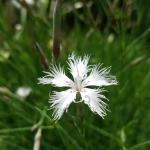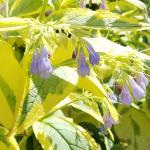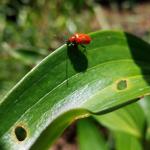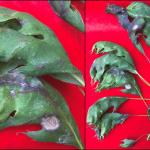UMass Extension's Landscape Message is an educational newsletter intended to inform and guide Massachusetts Green Industry professionals in the management of our collective landscape. Detailed reports from scouts and Extension specialists on growing conditions, pest activity, and cultural practices for the management of woody ornamentals, trees, and turf are regular features. The following issue has been updated to provide timely management information and the latest regional news and environmental data.
To read individual sections of the message, click on the section headings below to expand the content:
Scouting Information by Region
Environmental Data
The following data was collected on or about June 20, 2018. Total accumulated growing degree days (GDD) represent the heating units above a 50° F baseline temperature collected via our instruments for the 2018 calendar year. This information is intended for use as a guide for monitoring the developmental stages of pests in your location and planning management strategies accordingly.
|
MA Region/Location |
GDD |
Soil Temp |
Precipitation |
Time/Date of Readings |
||
|
1-Week Gain |
2018 Total |
Sun |
Shade |
|||
|
Cape Cod |
119 |
547 |
65 |
69 |
0.12 |
3:00 PM 6/20 |
|
Southeast |
n/a |
n/a |
n/a |
n/a |
n/a |
n/a |
|
North Shore |
128.5 |
665.5 |
65 |
61 |
0.36 |
9:00 AM 6/20 |
|
East |
149.5 |
754 |
65 |
62 |
0.30 |
8:00 AM 6/20 |
|
Metro West |
124 |
665 |
63 |
60 |
0.54 |
5:35 AM 6/20 |
|
Central |
118 |
600 |
62 |
58 |
0.19 |
6:30 AM 6/20 |
|
Pioneer Valley |
134 |
745 |
76 |
68 |
0.75 |
1:00 PM 6/19 |
|
Berkshires |
124 |
696 |
69 |
62 |
0.85 |
8:00 AM 6/20 |
|
AVERAGE |
128 |
668 |
66 |
63 |
0.44 |
- |
|
n/a = information not available |
||||||
Drought conditions update: As of June 21, Massachusetts is experiencing level D0 - 'Abnormally Dry' - in all areas of the following counties: Berkshire, Franklin, Hampshire, Hampden, Worchestershire, Middlesex and Essex. The western half of Norfolk County is also rated D0. Use this link to view the map:
http://droughtmonitor.unl.edu/CurrentMap/StateDroughtMonitor.aspx?MA
Phenology
| Indicator Plants - Stages of Flowering (BEGIN, BEGIN/FULL, FULL, FULL/END, END) | ||||||||
|---|---|---|---|---|---|---|---|---|
| PLANT NAME (Botanic/ Common) | CAPE | S.E. | N.S. | EAST | METRO W. | CENT. | P.V. | BERK. |
|
Itea virginica (Virginia Sweetspire) |
* |
* |
Begin |
* |
* |
* |
Begin |
Begin |
|
Sambucus canadensis (American Elderberry) |
Begin |
* |
Full |
* |
Full |
Full |
Full |
Begin/Full |
|
Ligustrum spp. (Privet) |
Begin |
* |
Full |
Begin |
Full |
Full |
Full |
Begin |
|
Catalpa speciosa (Northern Catalpa) |
Begin |
* |
Full |
Full/End |
Full |
Full |
Full/End |
Full |
|
Syringa reticulata (Japanese Tree Lilac) |
Full |
* |
Full |
End |
Full/End |
Full |
Full/End |
Full |
|
Hydrangea anomala petiolaris (Climbing Hydrangea) |
Full |
* |
Full/End |
Full/End |
Full/End |
Full |
Full/End |
Full |
|
Kalmia latifolia (Mountain-laurel) |
Full |
* |
Full/End |
End |
Full/End |
Full |
Full/End |
Full |
|
Cotinus coggygria (Common Smokebush) |
Full/End |
* |
Full/End |
End |
Full/End |
Full |
Full/End |
Full/End |
| * = no activity to report/information not available | ||||||||
Regional Notes
Cape Cod Region (Barnstable)
General Conditions: The average temperature over the last week was 67°F with a high of 83°F June 17 and a low of 51°F on June 15. Conditions have been favorable for working outdoors with daytime temperatures primarily being in the 70s. Approximately one tenth of an inch of precipitation has fallen, split between two events on June 13 and 18. Topsoil moisture is short, subsoil moisture remains adequate. Breezy conditions that have occurred over the last week have exacerbated plant transpiration and evaporation from soil leading to rapidly drying conditions. Unirrigated turf on coarse soils are already showing some browning from lack of moisture.
Pests/Problems: Gypsy moth are still feeding. They can be more readily found at this time due to their larger size (primarily 4th and 5th instars). The Outer Cape has the heaviest feeding (which is still less than was seen in the previous 2-3yrs). The Mid, Lower and Upper Cape have only a few isolated spots with damage. Insects observed over the last week include wooly elm aphid (Eriosoma americanum) on American elm, cottony camellia scale (Pulvinaria floccifera) on American holly, azalea scale (Ericoccus azaleae) on Rhododendron, Lecanium scale on oak, Viburnum leaf beetle (larvae) on Viburnum and native holly leafminer on American holly. Insect damage seen over the last week includes rose slug sawfly damage on rose, columbine leafminer on columbine, turpentine beetle on pitch pine and earwig damage to annuals. Diseases observed over the last week include anthracnose on sycamore (few healthy leaves have been able to develop as of yet on susceptible sycamores), cedar apple rust on crabapple, apple scab on crabapple, leaf spot on birch, black spot on rose, anthracnose on hosta, downy mildew on ornamental hops and red thread in turf. The following weeds are in bloom: black swallowwort (Cynanchum nigrum), Oriental bittersweet (Celastrus orbiculatus), multiflora rose (Rosa multiflora), mouse-ear chickweed (Cerastium vulgatum), red sorrel (Rumex acetosella), curly dock (Rumex crispus), narrowleaf plantain (Plantago lanceolata), black medic, (Medicago lupulina), white clover (Tricolium repens), annual fleabane (Erigeron annuus), prostrate spurge (Euphorbia maculata) and common groundsel (Senecio vulgaris). Rabbits are abundant. Black legged tick (deer tick) nymphs are active - keep your self protected with permethrin treated shoes and clothing.
Southeast Region (Hanson)
No report available this week.
North Shore Region (Beverly)
General Conditions: The first half of this reporting period, daytime temperatures were in the low to mid 70s and nighttime temperatures were in the mid 50s. In the second half of the period, daytime temperatures climbed to mid 80s and nighttime temperatures were in the mid 60s. On June 18, temperatures above 90 degrees Fahrenheit, with high relative humidity, were recorded. The last few weeks have been dry but on June 18, a powerful storm passed through at night bringing some needed precipitation, although only 0.36 of an inch of rainfall was recorded at Long Hill. Woody plants seen in bloom include: tulip tree (Liriodendron tulipifera), Japanese tree lilac (Syringa reticulata), Peking tree lilac (Syringa pekinensis), Stewartia (Stewartia rostrata), privet (Ligustrum spp.), Kousa dogwood (Cornus kousa), Lemoine Deutzia (Deutzia lemoinei), Sweet azalea (Rhododendron arborescens), Virginia sweetspire (Itea virginica), magician Deutzia (Deutzia magicien) and mountain laurel (Kalmia latifolia). Herbaceous plants in bloom include: Peonies (Paeonia spp.), Virginia rose (Rosa virginiana), Baptisia (Baptisia australis), foxglove (Digitalis purpurea), spiderwort (Tradescantia spp.), leopard’s bane (Doronicum spp.), meadowsweet (Filipendula ulmaria), catmint (Nepeta spp.), geranium (Pelargonium spp.), Rodger's flower (Rodgersia aesculifolia), Aruncus (Aruncus dioicus), Corydalis (Corydalis lutea), Allium (Allium spp.), ox-eye daisy (Leucanthemum vulgare) and annual flowers.
Pests/Problems: Serious deer browsing was observed on hosta. Browsing was also observed on other plants including roses and vegetable crops such as lettuce. Blister galls were observed on grape vine leaves. These are probably caused by blister gall midge and do not usually cause economic injury to the vine so no control measures are recommended. Removing the galls may be of some benefit in reducing the numbers of midges present. Viburnum leaf beetle larvae are now in the pupation stage so are not feeding on the leaves. Rose slug sawfly larvae also seem to have gone into pupation as they are no longer being observed skeletonizing rose leaves. Poison ivy is growing vigorously in the landscape. Learn how to identify poison ivy to prevent exposure. Multiflora rose (Rosa multiflora) continues to bloom and is easy to identify. Weeds in the landscape continue to flourish. Take measures to control weeds before they set seed. Mosquitoes and ticks are still very active. Protect yourself with insect repellent when working outdoors especially at dawn and at dusk.
East Region (Boston)
General Conditions: High temperatures ranged from 69°F to 89°F, averaging 80.6°F; low temperatures ranged from 53°F to 65°F, averaging 59.6°F. We received only 0.30 inches of precipitation over the last week as a fast-moving thunderstorm moved through the area on the evening of the 18th. The majority fell over a 15-minute period, reducing humidity and leaving behind more bearable conditions. Plants in bloom include Achillea millefolium (common yarrow), Alchemilla mollis (lady's mantle), Baptisia australis (blue wild indigo), Campanula takesimana ‘Elizabeth’ (Korean bellflower), Catalpa speciosa (northern Catalpa), Clematis spp. (Clematis), Coreopsis spp. (tickseed), Dianthus spp. (pinks), Digitalis purpurea (common foxglove), Hemerocallis 'Stella D'Oro' (daylily), Ilex pedunculosa (longstalk holly), Kalmia latifolia (mountain laurel), Lavendula angustifolia (English lavender), Leucanthemum vulgare (oxeye daisy), Lilium spp. (true lily), Lonicera sempervirens (trumpet honeysuckle), Nepeta spp. (catmint), Oenothera macrocarpa (bigfruit evening primrose), Potentilla fruticosa (Potentilla), Rosa rugosa (rugosa rose), Salvia nemerosa (woodland sage), Scabiosa 'Butterfly Blue' (pincushion flower), Spiraea japonica (Japanese meadowsweet), Syringa reticulata (Japanese tree lilac), Thymus praecox (mother-of-thyme), and Veronica spp. (speedwell). Following the rain, the mycoheterotrophic Monotropa uniflora (Indian pipe) were observed popping up through leaf litter in natural woodlands.
Pests/Problems: The warm temperatures and lack of rain has left soils dry. In sunny areas, Impatiens capensis (orange jewelweed) is flagging due to the lack of soil moisture. All newer plantings (over the last three years) are receiving additional irrigation. Soils lacking organic matter have become hydrophobic. Weeds in flower include: Cynanchum louiseae (black swallowwort), Galinsoga quadriradiata (shaggy soldier), Lepidium virginicum (Virginia pepperweed), Matricaria discoidea (pineappleweed), Senecio vulgaris (groundsel), Solanum dulcamara (bittersweet), and Urtica dioica (stinging nettle). Leaves of hawthorn have been turning brown and are exhibiting a torched appearance; hawthorn leafminer (Profenusa canadensis) is the culprit, actively feeding on the inner leaf.
Metro West (Acton)
General Conditions: Summer has arrived and it sure feels like it! A high of 90°F was recorded on the 17th and a high of 91°F was recorded on the 18th. Not only was it hot, but it was humid as well. A storm passed through the area in the early evening on Monday the 18th and alleviated the humidity and heat. The landscape is lush and colorful with all that is in bloom. In some stage of bloom at this time are the following woody plants: Catalpa speciosa (northern Catalpa), Cornus kousa (Kousa dogwood), C. x rutgersensis 'Ruth Ellen' (Rutgers hybrid dogwood), Cotinus coggygria (common smokebush), Kalmia latifolia (mountain laurel), Kolkwitzia amabilis (beautybush), Ligustrum spp. (privet), Liriodendron tulipifera (tulip tree), Philadelphus coronarius (sweet mock orange), Potentilla fruiticosa (Potentilla), Rosa rugosa (rose), R. 'Knockout' (the Knockout family of roses), Rosa spp. (rose), Rubus spp. (blackberry, bramble, raspberry), Sambucus canadensis (elderberry), Spirea japonica 'Alpina' (Daphne Spirea), Stewartia psuedocamellia (Japanese Stewartia), Syringa reticulate (Japanese tree lilac)and Tilia cordata (littleleaf linden). Woody vines in bloom are: Clematis spp. (Clematis), Lonicera sempirvirens (trumpet honeysuckle) and Wisteria spp. (Wisteria).
Contributing even more color and interest to the landscape are some flowering herbaceous plants including: Achillea millefoliumn (yarrow), Alchemilla mollis (lady's mantle), Amsonia hubrichtii (Arkansas blue star), Aruncus dioicus (goat’s geard), Astilbe spp. (false Spirea), Baptisia australis (false blue indigo), Campanula persicifolia (peach-leafed bell flower), C. takesimana ‘Elizabeth’ (bellflower), Chrysogonum virginianum (green and gold), Clematis recta 'Purpurea' (Clematis), Coreopsis spp. (tickseed), Dianthus deltoides (maiden pinks), Dicentra eximia (fringed bleeding heart), Digitalis purpurea (foxglove), Filipendula spp. (meadow sweet), Geranium cantabrigiense 'Biokovo' and 'Cambridge' (hardy cranesbill), G. macrorrhizum (bigroot Geranium), G. sanguineum (cranesbill Geranium), G. ‘Johnson’s Blue’ (cranesbill), Gillenia trifoliata (bowman’s root), Hemerocallis fulva (orange daylily), H. 'Stella D'Oro' (daylily) and H. spp. (daylily), Heuchera spp. (coral bells), Iris germanica (bearded Iris), Lupinus 'Russell Woodfield Hybrids' (lupine), Leucanthemum spp. (shasta daisy), Lilium spp. (lily), Lychnis coronaria (rose campion), Maianthemum racemosum (false Solomon’s seal), Nepeta spp. (Ornamental catmint), Oenothera macrocarpa (Ozark sundrops), Paeonia spp. (peony), Papaver orientale (poppy), Penstemon digitalis 'Husker Red' (beardtongue), Potentilla tridentata (cinquefoil), Primula spp. (primrose), Salvia nemerosa (Salvia), Sedum kamschaticum (Russian stonecrop), Silene latifolia (white campion), Stachys byzantina (lamb’s ear), Thermopsis caroliniana (southern lupine), Thymus praecox (thyme), Tradescantia spp. (spiderwort) and Veronica spp. (speedwell).
Pests/Problems: The lack of any substantial rain is a concern for our trees and shrubs in the landscape, especially compounded with any other stresses such as winter or gypsy moth caterpillars, hemlock woolly adelgid, snow and ice removal applications or previous years’ droughts. The historical monthly average rainfall for June is 3.93” and the total for the month so far is now at only 1.16”.
Central Region (Boylston)
General Conditions: The drier conditions persisting with only 0.19” of rain recorded, combined with several days of upper 80’s and mid 90’s, are causing visible drought stress on non-irrigated areas, especially turf. Many plants are going out of bloom, but some of the trees, shrubs and vines that are still producing an eye catching display include: mountain laurel (Kalmia latifolia), Japanese tree lilac (Syringa reticulata), kousa dogwood (Cornus kousa) and northern Catalpa (Catalpa speciosa). Some herbaceous perennials and bulbsblooming include: woodland sage (Salvia nemorosa), smooth phlox (Phlox glaberrima ‘Triple Play’), yellow meadow rue (Thalictrum flavum subsp. glaucum), bowman’s root (Gillenia trifoliata), giant fleece flower (Persicaria polymorpha), pinks (Dianthus ‘Little Maiden’) and Russian comfrey (Symphytum x uplandicum ‘Axminster Gold’).
Pests/Problems: Gypsy moth caterpillars continue to feed, causing some defoliation of trees - mainly oak - but damage has also been noted on crabapple, witch hazel, birch, rose and maple. A few lily leaf beetles were spotted, as well as the three-lined potato beetle.
Pioneer Valley Region (Amherst)
General Conditions: Building heat and dry conditions persisted in the Pioneer Valley over this past week with a brief, but intense, rain event providing some badly needed moisture. Fiercely hot summer weather gripped the valley on Monday, 6/18 when high temperatures climbed into the lower to middle 90s. In the early afternoon hours, the heat index reached 100° F at Barnes Airport in Westfield when both the ambient air temperature and dew point peaked at 93° F and 71°, respectively (http://www.wpc.ncep.noaa.gov/html/heatindex.shtml). In addition to the heat, winds were persistent with sustained winds >15 mph and gusts approaching 30 mph. In the early evening hours, multiple bands of strong thunderstorms moved through the region, tracking northwest to southeast through the valley. A deluge of rain convoyed with abundant thunder and lightning as the storms quickly moved through. It really is an amazing sight to see such an enormous volume of rain in such a short period of time. Winds were gusty and localized; tree damage was reported with multiple power outages. A funnel cloud was confirmed in Granby by the National Weather Service, although it never made contact with the ground, thus was not a tornado. Accumulations from the storm were fairly consistent throughout the valley, ranging from 0.6 to 1” with localized accumulations >1.5”. Despite the rainfall, soils remain dry due to below-average precipitation over the past month. As expected, the entire tri-county region is now classified as “abnormally dry” in the most recent map produced by the U.S. Drought Monitor (http://droughtmonitor.unl.edu/CurrentMap/StateDroughtMonitor.aspx?MA). Monday, 6/18 was not a nice day to be a tree, with both drying winds and high heat and humidity. Because trees are highly advanced organisms, they deal with intense heat in interesting ways. Oaks, for example, alter the morphology of leaves depending on their position in the canopy. Leaves in the upper canopy, called “sun leaves”, are often smaller, thicker and more deeply lobed. In contrast, leaves in the lower canopy, called “shade leaves”, are often larger, thinner and have more shallow lobes. By having deeper lobes and a smaller surface area, sun leaves are able to increase rates of heat conduction to the leaf margins to avoid overheating and reduce water loss from transpiration. Sun leaves must compensate for the smaller surface area by packing in more chlorophyll, in order to take advantage of the full sun setting for photosynthesis. This creates a thicker leaf compared to shade leaves.
Pests/Problems: Drought stress is now a primary concern with the sun at its zenith and below-average precipitation during May and June. Mandatory water use restrictions on outdoor watering are becoming more abundant throughout the Commonwealth. You can see the status of your specific town here: https://www.mass.gov/doc/water-use-restrictions-map Despite the dry weather, leaf scorch and wilt symptoms are not yet common but will be if the dry conditions continue. Drought stress in deciduous plants is far easier to detect and remedy while for conifers, irreversible drought stress can develop without any noticeable symptoms, owing to their thick, waxy needles. Various leaf spot, blotch and anthracnose fungi are present on deciduous trees and shrubs in the landscape at this time. For trees with existing infections, the damage is done. But, if new growth continues, treatment of these immature plant parts can help to avoid additional infections. The dry weather has helped to slow many of these fungi, but in some cases, high humidity affords the necessary environmental conditions for spore germination and invasion. Rhododendron, azalea, holly and other broad-leaved evergreens that took a beating from last winter will require extra care this season. Continue to scout for and prune dead leaves and branches to avoid further problems. A common pathogen on Rhododendron is Pestalotiopsis, the cause of gray leaf blight. This fungus will linger on dead leaves and stems and spread to adjacent parts of the canopy if left. Check soil pH to
determine if any modifications might improve overall vigor and irrigate if dieback was significant. Lacebug infestations can dramatically reduce vigor of Rhododendron, azalea and Andromeda so treat these pests in addition to any others that might be present.
Berkshire Region (Great Barrington)
General Conditions: The transition from spring to summer is feeling more like the transition from mid-summer to late summer as near record high temperatures occurred on June 17 (92°F) and 18 (95 F) at this monitoring site in south Berkshire County. Not only was the weather hot, but steady breezes in combination with a lack of rainfall over the previous 13 days left soils very dry. Rain did fall on the evening and night of June 18, depositing 0.85 inches. Prior to that, the only measurable rainfall fell back on June 5 (0.10 inches). Total rainfall for the month, up to June 20, is 1.61 inches. The heat and dry conditions has impacted the landscape somewhat. No symptoms of heat scorch were evident but the flowering period of many herbaceous perennials and annuals was shortened. Also, growth of turfgrass was slowed. In some cases, there was drought related browning of grass.
Pests/Problems: Disease incidence on plant materials has been sparse, perhaps due to lack of rainfall and low humidity. The most frequently observed diseases are black spot on roses, apple scab and cedar apple rust on crabapples, powdery mildew on Physocarpus (ninebark) and lilacs. Some anthracnose was found on a few tree species but was minimal. Weir’s spruce cushion rust is now infecting this season’s needles on spruce. Boxwood psyllids have left behind remnants of waxy fibers in cupped leaves of new growth on boxwood but the psyllids were not seen. The adult flies of boxwood leaf miner can still be seen if one shakes the branches of boxwood, but the numbers are greatly reduced over that of last week, indicating that this phase of the leaf miner life cycle is about over. Their eggs have been deposited in the new growth leaves. This would be a good time to control this pest by pruning the new growth. A few cankerworms were found eating holes in the leaves of roses. Woolly beech aphid, imported willow leaf beetle (larvae and adults) and spruce spider mite remain active. Perhaps the most interesting insect pest observed during this monitoring period was the golden tortoise beetle (Charidotella sexpunctata). Its name is appropriate as the shell of this beetle is shiny gold in color. The one specimen found was probably a late bloomer as the beetle which overwinters in the adult stage lays its eggs in the developing foliage of morning glories and bindweed in mid-spring. Rabbit and chipmunk populations are very high this spring and complaints about their dining and excavating habits are quite common. Voles are also causing problems in home gardens as they dine on young seedlings of annuals.
Regional Scouting Credits
- CAPE COD REGION - Russell Norton, Horticulture and Agriculture Educator with Cape Cod Cooperative Extension, reporting from Barnstable.
- SOUTHEAST REGION - Deborah Swanson, UMass Extension Horticulturist for Plymouth County - Retired, reporting from Hanson.
- NORTH SHORE REGION - Geoffrey Njue, Green Industry Specialist, UMass Extension, reporting from the Long Hill Reservation, Beverly.
- EAST REGION - Kit Ganshaw & Sue Pfeiffer, Horticulturists, reporting from the Arnold Arboretum, Jamaica Plain.
- METRO WEST REGION - Julie Coop, Forester, Massachusetts Department of Conservation & Recreation, reporting from Acton.
- CENTRAL REGION - Dawn Davies, Interim Horticulture Manager, reporting from Tower Hill Botanic Garden, Boylston.
- PIONEER VALLEY REGION - Nick Brazee, Plant Pathologist, UMass Extension Plant Diagnostic Lab, reporting from UMass Amherst.
- BERKSHIRE REGION - Ron Kujawski, Horticultural Consultant, reporting from Great Barrington.
Woody Ornamentals
Diseases
Marginal leaf blight of Rhododendron (Rhododendron maxima) caused by Pestalotiopsis and Phomopsis. The shrub is eight-years-old and has been present at the site for one year. This spring, leaves in the canopy began to turn brown, primarily along the margins, becoming gray-colored over time. The plant resides in a shaded setting with sandy soils and drip irrigation. Transplant shock and winter burn likely contributed to the leaf blight.
Coral-sport Nectria canker, caused by Nectria cinnabarina, on Japanese maple (Acer palmatum). Tree is 20-years-old and has been present at the site for 15 years. The tree has been exhibiting general dieback symptoms, including shoot tip death. The tree resides near a house in a small planting bed with full sun and lawn irrigation. In 2017, the tree was treated with a bark spray of Phosphorous acid with Pentra-Bark. There was no evidence of Verticillium wilt from the submitted stems and branches.
Oak anthracnose, caused by Apiognomonia errabunda, on red oak (Quercus rubra). Multiple trees, approximately 30-years-old, planted along a driveway in a residential setting 20 years ago. The canopies appear thin and leaves are undersized and distorted with dark-colored patches of necrotic tissue (see photos below). Cream-colored spore masses were abundant on the submitted sample. The trees receive some supplemental water from lawn sprinklers.
Phytophthora root and crown rot of Siberian cypress (Microbiota decussata) and Rhododendron. Nursery plants that are two- and three-years-old, respectively. The Rhododendron exhibited browning leaves and canopy dieback while the cypress had drying and yellowing needles throughout the canopy. Root and crown tissue was necrotic and had a bluish-stain in the vascular tissue, typical of some Phytophthora species that are common on landscape and forest trees and shrubs.
Decline and dieback of eastern white pine (Pinus strobus) caused by brown needle spot (Lecanosticta acicola) and Diplodia blight (Diplodia sapinea). Tree is approximately 60-years-old and resides in a full sun setting in loamy, well-drained soils. Arborist noted significant needle shedding with large volumes of dead needles under the tree. There were also cankers on lower limbs extruding pitch. Brown needle spot is one of the most important needle blight pathogens of eastern white pine. Diplodia blight can be high destructive on five-needle pines when they are stressed, as is the case here.
Severe infestation of the elongate hemlock scale (Fiorinia externa) on balsam fir (Abies balsamea). Tree is approximately 15-years-old and has been present at the site for over 10 years. Homeowner noticed the tree was stressed roughly two years ago when branch dieback and premature needle shedding became apparent. The damage is most severe in the lower 3’ of the canopy but overall the dieback is scattered throughout the canopy. The infestation has been present for many years, given the number of scales present on the submitted sample.
Report by Nick Brazee, Plant Pathologist, UMass Extension Plant Diagnostic Lab, UMass Amherst.
Insects
Noteworthy Sighting:
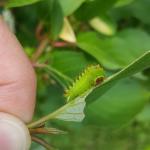 Polyphemus Caterpillar: (Antheraea polyphemus) The caterpillars of this species of giant silkworm moths (Saturniinae) are almost fluorescent green in color, with yellow lines that pass from spiracle to spiracle on certain abdominal segments. (Spiracles are respiratory openings on the sides of the caterpillar’s body.) This earlier instar caterpillar has orange-colored warts, each having 2-5 setae (hairs). These warts change color in older caterpillars to a more silver and red color. The head is orange-brown in color. This particular caterpillar was found feeding on dogwood near an ornamental pond in Amherst, MA on 6/20/18. Many trees and shrubs provide food for these caterpillars, including apple, birch, ash, elm, hazel, hickory, maple, oak, rose, and willow. There is one generation per year in the Northeast, and broods have been reported from May – July. Caterpillars are solitary feeders. Eventually, they descend their host plant to pupate in the leaf litter. Occasionally, cocoons are attached to host plants. This caterpillar will turn into the very large (wingspan approximately 4-6 inches), charismatic Polyphemus moth which generally has brown with other markings, including magnificent eyespots. Originally, these plants were being scouted with the intent of detecting any signs of early dogwood sawfly activity. No sawflies were detected at this particular planting, but it was a lucky occurrence to run into this beautiful Polyphemus caterpillar.
Polyphemus Caterpillar: (Antheraea polyphemus) The caterpillars of this species of giant silkworm moths (Saturniinae) are almost fluorescent green in color, with yellow lines that pass from spiracle to spiracle on certain abdominal segments. (Spiracles are respiratory openings on the sides of the caterpillar’s body.) This earlier instar caterpillar has orange-colored warts, each having 2-5 setae (hairs). These warts change color in older caterpillars to a more silver and red color. The head is orange-brown in color. This particular caterpillar was found feeding on dogwood near an ornamental pond in Amherst, MA on 6/20/18. Many trees and shrubs provide food for these caterpillars, including apple, birch, ash, elm, hazel, hickory, maple, oak, rose, and willow. There is one generation per year in the Northeast, and broods have been reported from May – July. Caterpillars are solitary feeders. Eventually, they descend their host plant to pupate in the leaf litter. Occasionally, cocoons are attached to host plants. This caterpillar will turn into the very large (wingspan approximately 4-6 inches), charismatic Polyphemus moth which generally has brown with other markings, including magnificent eyespots. Originally, these plants were being scouted with the intent of detecting any signs of early dogwood sawfly activity. No sawflies were detected at this particular planting, but it was a lucky occurrence to run into this beautiful Polyphemus caterpillar.
Woody ornamental insect and non-insect arthropod pests to consider, a selected few:

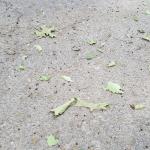
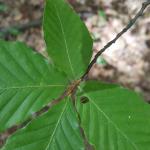


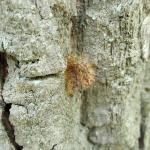 Gypsy Moth: (Lymantria dispar) host plants include but are certainly not limited to oak (favored), maple, birch, poplar, and many others. Gypsy moth caterpillars continue to feed and grow in size. Caterpillars observed on 6/20/18 in Amherst, MA are variable in size, but some are 2 inches in length at this time. 5th instar caterpillars will be present in most locations at this time. However, caterpillars may be of different sizes, depending upon your location in MA. (See Regional Reports above.) Caterpillars have the red and blue pairs of warts or raised bumps recognizable in older gypsy moth caterpillars. They also have yellow coloration to their head capsule. By June 24th and 25th in 2017, an epizootic (outbreak) of the fungus Entomophaga maimaiga had occurred. While scouting at a location in Amherst, MA on 6/20/18, some caterpillar mortality due to the fungus was detected. Shriveled, dried, and spore covered caterpillars were seen stuck hanging vertically from trees at this one location. One juicy caterpillar hanging in an inverted-V shape (typical of a NPV virus-killed caterpillar) was also observed at this site. However, the number of dead caterpillars stuck to the sides of trees (as of 6/20/18) was not as great as what was observed last year.
Gypsy Moth: (Lymantria dispar) host plants include but are certainly not limited to oak (favored), maple, birch, poplar, and many others. Gypsy moth caterpillars continue to feed and grow in size. Caterpillars observed on 6/20/18 in Amherst, MA are variable in size, but some are 2 inches in length at this time. 5th instar caterpillars will be present in most locations at this time. However, caterpillars may be of different sizes, depending upon your location in MA. (See Regional Reports above.) Caterpillars have the red and blue pairs of warts or raised bumps recognizable in older gypsy moth caterpillars. They also have yellow coloration to their head capsule. By June 24th and 25th in 2017, an epizootic (outbreak) of the fungus Entomophaga maimaiga had occurred. While scouting at a location in Amherst, MA on 6/20/18, some caterpillar mortality due to the fungus was detected. Shriveled, dried, and spore covered caterpillars were seen stuck hanging vertically from trees at this one location. One juicy caterpillar hanging in an inverted-V shape (typical of a NPV virus-killed caterpillar) was also observed at this site. However, the number of dead caterpillars stuck to the sides of trees (as of 6/20/18) was not as great as what was observed last year.
As of this date at this particular location, the sound of falling gypsy moth caterpillar frass (excrement) could be heard falling from tree canopies, a sound analogous to that of a soft rain. Frass could be seen on understory leaves, paved pathways, and vehicles. At this location in Amherst, shredded and partially fed upon leaves also littered pathways beneath the feeding caterpillars. Nearly completely defoliated oaks could be seen at the intersection of Bay Road and West Street (Rt. 116) in Amherst as of 6/20/18. Most of the calls/reports regarding gypsy moth defoliation, raining frass, and shredded leaves have come in to Extension from Amherst, Belchertown, Bolton, Boylston, Gloucester, Hanson, Ware, and Worcester (multiple), MA so far in 2018. Shredded leaves and partial defoliation of trees was reported in Ware, MA and it was noted that the activity there, although certainly noticeable, is not as bad as it was by this time last year. Raining frass was heard in Hanson, MA and some completely defoliated trees have been reported in Boylston, MA. Defoliation has also been reported in Gloucester, MA. Thanks to the Entomophaga maimaiga activity in 2017, hopefully we will not see entire hillsides of defoliation, as was seen by July 1st in 2017 in Belchertown, MA, among other locations. (See last year’s Landscape Message.)
Despite the fungal outbreak that swept through the 2017 caterpillar population, some lucky caterpillars survived to pupation and emerged as adult moths. (However, adults were present in 2017 in far fewer numbers than would have existed without the fungus.) While it is very difficult to predict how much total defoliation Massachusetts will see in 2018 due to gypsy moth caterpillar feeding, we can be certain that in areas where many egg masses were seen overwintering, and where caterpillars are still feeding, pockets of defoliation could still occur in certain areas of the state this year. Thanks to the gypsy moth caterpillar-killing fungus, however, the population should be on the decline.
- Asian Longhorned Beetle: (Anoplophora glabripennis, ALB) Look for signs of an ALB infestation which include perfectly round exit holes (about the size of a dime), shallow oval or round scars in the bark where a female has chewed an egg site, or sawdust-like frass (excrement) on the ground nearby host trees or caught in between branches. Be advised that other, native insects may create perfectly round exit holes or sawdust-like frass, which can be confused with signs of ALB activity. Adult insects may be seen beginning in July in the regulated area in Massachusetts. The regulated area for Asian longhorned beetle is 110 miles2 encompassing Worcester, Shrewsbury, Boylston, West Boylston, and parts of Holden and Auburn. If you believe you have seen damage caused by this insect, such as exit holes or egg sites, on susceptible host trees like maple, or believe you have captured or taken a photo of an adult insect, please call the Asian Longhorned Beetle Eradication Program office in Worcester, MA at 508-852-8090 or toll free at 1-866-702-9938.
To report an Asian longhorned beetle find online or compare it to common insect look-alikes, visit: http://massnrc.org/pests/albreport.aspx or https://www.aphis.usda.gov/pests-diseases/alb/report
- Deer Tick/Blacklegged Tick: Ixodes scapularis adult females, following a blood meal, can lay a single egg mass (up to 1500 – 2000 eggs) in mid-late May, then the female deer tick perishes. Larvae emerge from the eggs later in the summer. Larvae are tiny and six-legged. Prior to feeding, they are not known to be able to transmit disease. After feeding, the larvae drop from their host and molt, re-emerging the following spring as nymphs. Nymphs (from last year’s overwintering cohort) are active from May-August. Nymphs are eight-legged and about the size of the head of a pin. These tiny nymphs typically attach to small mammal hosts; however, they will readily feed on people and pets. Nymphs are capable of carrying Lyme disease, human Babesiosis, human Anaplasmosis, and deer tick virus. For images of all deer tick life stages, along with an outline of the diseases they carry, visit: http://www.tickencounter.org/tick_identification/deer_tick .
Anyone working in the yard and garden should be aware that there is the potential to encounter deer ticks. The deer tick or blacklegged tick can transmit Lyme disease, human Babesiosis, human Anaplasmosis, and other diseases. Preventative activities, such as daily tick checks, wearing appropriate clothing, and permethrin treatments for clothing (according to label instructions) can aid in reducing the risk that a tick will become attached to your body. If a tick cannot attach and feed, it will not transmit disease. For more information about personal protective measures, visit: http://www.tickencounter.org/prevention/protect_yourself .
Have you just removed an attached tick from yourself or a loved one with a pair of tweezers? If so, consider sending the tick to the UMass Laboratory of Medical Zoology to be tested for disease causing pathogens. To submit a tick to be tested, visit: https://www.tickreport.com/ and click on the red “Test A Tick” button. Results are typically available within 3 business days, or less. By the time you make an appointment with your physician following the tick attachment, you may have the results back from TickReport to bring to your physician to aid in a conversation about risk.
The UMass Laboratory of Medical Zoology does not give medical advice, nor are the results of their tests diagnostic of human disease. Transmission of a pathogen from the tick to you is dependent upon how long the tick had been feeding, and each pathogen has its own transmission time. TickReport is an excellent measure of exposure risk for the tick (or ticks) that you send in to be tested. Feel free to print out and share your TickReport with your healthcare provider.
You can also follow TickReport on Twitter @TickReport for timely updates from the Laboratory of Medical Zoology, including the latest tick and tick-borne disease related research.
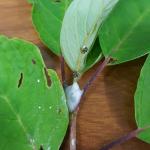
 Dogwood Spittlebug: (Clastoptera proteus) occurs in New England, wherever dogwoods are grown. This species may also feed on Vaccinium and Aesculus. Adults and nymphs of this hemipteran are found feeding on the same host. The adult insect is called a froghopper. Eggs are laid in punctures created by adults in the bark of outer twigs. Each puncture may contain 1-3 eggs. Eggs overwinter and nymphs emerge in June and early July. A sugary, frothy substance is created by the feeding nymphs, as they secrete excess sap as they feed, causing it to froth by pumping air into this excrement. They can be completely hidden in this “spittle”. Dogwood spittlebug activity was seen in Amherst, MA on 6/20/2018. The impact these insects have is largely aesthetic, and management is rarely necessary.
Dogwood Spittlebug: (Clastoptera proteus) occurs in New England, wherever dogwoods are grown. This species may also feed on Vaccinium and Aesculus. Adults and nymphs of this hemipteran are found feeding on the same host. The adult insect is called a froghopper. Eggs are laid in punctures created by adults in the bark of outer twigs. Each puncture may contain 1-3 eggs. Eggs overwinter and nymphs emerge in June and early July. A sugary, frothy substance is created by the feeding nymphs, as they secrete excess sap as they feed, causing it to froth by pumping air into this excrement. They can be completely hidden in this “spittle”. Dogwood spittlebug activity was seen in Amherst, MA on 6/20/2018. The impact these insects have is largely aesthetic, and management is rarely necessary.- Elongate Hemlock Scale: Fiorinia externa is found on eastern, Carolina, and Japanese hemlock, as well as yew, spruce, and fir. Crawlers will be present this month and throughout the growing season and the overlap of many developmental stages at any given time can be observed. Treatments (active ingredients effective through contact) for the crawler, or mobile, stage of this insect may be made in late May through mid-June, or between 360-700 GDD’s, base 50°F. (Systemic options can be made at other times, such as the spring and fall.)
- Emerald Ash Borer: (Agrilus planipennis, EAB) This wood-boring beetle readily attacks ash (Fraxinus spp.) including white, green, and black ash, has also been found developing in white fringe tree (Chionanthus virginicus) and most recently, has been reported in cultivated olive (Olea europaea). Signs of an EAB infested tree may include D-shaped exit holes in the bark (from adult emergence), “blonding” or lighter coloration of the ash bark from woodpecker feeding (chipping away of the bark as they search for larvae beneath), and serpentine galleries visible through splits in the bark, from larval feeding beneath. Positive identification of an EAB-infested tree may not be possible with these signs individually on their own. For further information about this insect, please visit: https://ag.umass.edu/fact-sheets/emerald-ash-borer . If you believe you have located EAB-infested ash trees, particularly in an area of Massachusetts not identified on the map provided, please report here: http://massnrc.org/pests/pestreports.htm .
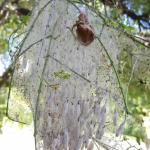
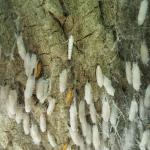 Euonymus Caterpillar: Yponomeuta cagnagella is of European origin and widespread in distribution throughout Europe. It was first reported in North America in Ontario in 1967. On 6/11/2018, a common spindle tree (Euonymus europaeus) on the UMass Amherst campus was found with a heavy infestation of euonymus caterpillars. The infested tree is approximately 3.1 miles away from the initial area in Amherst, MA reported on for this insect. On 6/11/18 in this location, the majority of caterpillars were found to be spinning white cocoons within which they pupate. Large sections of this individual tree are covered in webbing and cocoons. Webbing falling from the tree covers the turf below, and some caterpillars are pupating in clumps of webbed turf. By 6/20/2018, all of the caterpillars at this location have pupated and are present in their white cocoons. A tiny percentage of the small adult moths have emerged as of 6/20/18 at this location. Moths are white with black spots.
Euonymus Caterpillar: Yponomeuta cagnagella is of European origin and widespread in distribution throughout Europe. It was first reported in North America in Ontario in 1967. On 6/11/2018, a common spindle tree (Euonymus europaeus) on the UMass Amherst campus was found with a heavy infestation of euonymus caterpillars. The infested tree is approximately 3.1 miles away from the initial area in Amherst, MA reported on for this insect. On 6/11/18 in this location, the majority of caterpillars were found to be spinning white cocoons within which they pupate. Large sections of this individual tree are covered in webbing and cocoons. Webbing falling from the tree covers the turf below, and some caterpillars are pupating in clumps of webbed turf. By 6/20/2018, all of the caterpillars at this location have pupated and are present in their white cocoons. A tiny percentage of the small adult moths have emerged as of 6/20/18 at this location. Moths are white with black spots.
The euonymus caterpillars (larvae) feed in groups and envelop the foliage of the host plant in webs as they feed. Hosts include: Euonymus europaeus (tree form), E. kiautschovicus, E. alatus, and E. japonicus. Mature caterpillars are just under an inch in length, creamy yellow-gray in color with black spots and a black head capsule. By late June, these larvae pupate in white, oval-shaped cocoons which are typically oriented together vertically either on host plants or non-hosts in the area. (See photos.) Cocoons can be found in cracks and crevices, or webbed together leaves. The adult moth emerges in late June in most locations. The adult female secretes a gummy substance over her eggs which will harden, making them even more difficult to see. Eggs hatch by mid-August, at which time the tiny larvae prepare to overwinter beneath their eggshell-like covering. These larvae are inactive until the following year, when caterpillars group together to feed on newly emerging leaves, creating a mess of webs as they feed. There is one generation per year. Plants may be partially or entirely defoliated.
- European Elm Scale: Gossyparia spuria is a type of felt scale and was observed on an elm on 6/13/17 in Amherst, MA. This particular tree held populations of this insect in 2017 as well. First noted in New York in 1884, this non-native scale is now widespread in North America and is found on native and European elms, but also rarely on hackberry and Zelkova. This insect can cause yellowing of foliage, premature leaf drop, and eventually dieback on its host. Honeydew and thus sooty mold are produced. The females observed in Amherst have produced a ring of white fibers around their black, oval bodies. By the end of June, these females will lay eggs that hatch into bright yellow crawlers, which will disperse to the midrib and leaf veins on the underside of elm leaves where they will remain to feed. Crawlers are tiny and magnification is necessary to observe. Natural enemies such as parasitic wasps and predatory insects have been reported as successful in managing this insect.
- Imported Willow Leaf Beetle: Plagiodera versicolora overwintered adults are present and continue to be active and found on willow foliage. Adult beetles will chew holes and notches in the leaves of willow. Egg laying was observed on 5/16/18, 5/23/18, and 5/30/2018 in Chesterfield, MA. Females lay yellow eggs in clusters on the undersides of leaves. As of 5/30/2018, eggs have hatched at the location in Chesterfield, MA and multitudes of small imported willow leaf beetle larvae are feeding in groups. By 6/13/2018, these larvae have grown larger in size and have skeletonized many leaves. Larvae are slug-like and bluish-green in color. They feed in clusters. Most plants can tolerate the feeding from this insect although foliage will appear brown. Repeated yearly feeding can be an issue, in which case management of the young larvae may be necessary. Take care with treatment in areas near water.
- Lace Bugs: Corythucha spp. and Stephanitis spp. lace bugs are active. Corythucha spp. utilize many hosts such as: hawthorn, cotoneaster, Amelanchier, quince, Pyracantha, various oaks, birch, maple, mountain ash, sycamore, hackberry, elm, walnut, butternut, basswood, etc. Corythucha spp. adult lace bugs were seen feeding on bur oak on 6/13/2018 in Amherst, MA. Many adult lace bugs were seen on leaf undersides, along with groups of tiny, black eggs. These groups of lace bug eggs were seen on nearly every leaf examined within reach on this tree. Eggs are so small, they may look like fungal spores without magnification.
Stephanitis spp. lace bugs are active and damage is becoming more apparent. Yellow stippling on leaf surfaces, black colored tar-like spots on leaf undersides, and lace bug nymphs (immatures) were seen on leaf undersides on 5/30/18, 6/7/18, and 6/13/18 in Amherst, MA on Rhododendron spp. foliage. Stephanitis spp. lacebugs such as S. pyriodes can cause severe injury to azalea foliage. S. rhododendri can be common on rhododendron and mountain laurel. S. takeyai has been found developing on Japanese andromeda, leucothoe, styrax, and willow. Stephanitis spp. lace bug activity should be monitored through September. Before populations become too large, treat with a summer rate horticultural oil spray as needed. Be sure to target the undersides of the foliage in order to get proper coverage of the insects. Fall or early spring soil treatment with imidacloprid has been effective, but be aware of the implications this may have on pollinators attracted to these flowering plants when making management decisions. Certain azalea and Andromeda cultivars may be less preferred by lace bugs.
- Lily Leaf Beetle: Lilioceris lilii overwintering adults continue to be active in Amherst, MA on 6/13/18. Susceptible hosts include Lilium spp. (Turk’s cap, tiger, Easter, Asiatic, and Oriental lilies) and Fritillaria spp. (Note: daylilies are not hosts.) Typically in May, mating will occur and each female will begin to lay 250-450 eggs in neat rows on the underside of the foliage. In Amherst, MA, orange lily leaf beetle eggs were observed on the underside of host plant foliage on 5/16/2018 and some of these eggs hatched by 5/23/18. Frass-covered larvae were observed feeding on 5/23/18, 5/30/18, 6/7/18, and 6/13/18 in Amherst, MA. Larvae are growing ever larger and eating entire leaves. Younger groups of eggs are hatching with still tiny larvae starting to feed by skeletonizing the leaf in groups. Where adults and larvae are seen, they can be removed from host plants with a gloved hand, where practical.
- Spotted Lanternfly: (Lycorma delicatula, SLF) is not known to occur in Massachusetts. This insect is a member of the Order Hemiptera (true bugs, cicadas, hoppers, aphids, and others) and the Family Fulgoridae, also known as planthoppers. This insect is a non-native species first detected in the United States in Berks County, Pennsylvania and confirmed on September 22, 2014. Until November 2017, this invasive insect was only known to Pennsylvania. It has now been reported from Delaware (November 20, 2017), New York (November 29, 2017), and most recently in Virginia (January 10, 2018). The Delaware Department of Agriculture announced the finding of a single female spotted lanternfly in New Castle County in the Wilmington, Delaware area. At this time, officials in Delaware note that it is unclear if this individual was an accidental hitchhiker, or evidence of an established population in the state. For more information about the find in Delaware, visit: https://news.delaware.gov/2017/11/20/spotted-lanternfly-confirmed-delaware/ . The New York State Department of Agriculture and Markets reported on November 29, 2017 the finding of a single dead individual spotted lanternfly in the state from earlier in the month. A single dead specimen was confirmed at a facility in Delaware County, New York, which is located south-west of Albany. The NYS Dept. of Agriculture and Markets states that this dead individual may have come in on an interstate shipment. For more information about the find in New York, visit: https://www.agriculture.ny.gov/AD/release.asp?ReleaseID=3637 . Most recently, Virginia Cooperative Extension announced the finding of a spotted lanternfly population in Frederick County, Virginia, on January 10, 2018. It was noted that at the location in Virginia, numerous adult lanternflies and egg masses were discovered, in addition to more at another site approximately 400 yards away. For more information about the find in Virginia, visit: https://ext.vt.edu/agriculture/commercial-horticulture/spotted-lanternfly.html .
The spotted lanternfly is considered native to China, India, and Vietnam. It has been introduced as a non-native insect to South Korea and Japan, prior to its detection in the United States. In South Korea, it is considered invasive and a pest of grapes and peaches. The spotted lanternfly has been reported from over 70 species of plants, including the following: tree of heaven (Ailanthus altissima) (preferred host), apple (Malus spp.), plum, cherry, peach, apricot (Prunus spp.), grape (Vitis spp.), pine (Pinus spp.), pignut hickory (Carya glabra), sassafras (Sassafras albidum), serviceberry (Amelanchier spp.), slippery elm (Ulmus rubra), tulip poplar (Liriodendron tulipifera), white ash (Fraxinus americana), willow (Salix spp.), American beech (Fagus grandifolia), American linden (Tilia americana), American sycamore (Platanus occidentalis), big-toothed aspen (Populus grandidentata), black birch (Betula lenta), black cherry (Prunus serotina), black gum (Nyssa sylvatica), black walnut (Juglans nigra), dogwood (Cornus spp.), Japanese snowbell (Styrax japonicus), maple (Acer spp.), oak (Quercus spp.), and paper birch (Betula papyrifera).
The adults and immatures of this species damage host plants by feeding on sap from stems, leaves, and the trunks of trees. In the springtime in Pennsylvania (late April - mid-May) nymphs (immatures) are found on smaller plants and vines and new growth of trees and shrubs. Third and fourth instar nymphs migrate to the tree of heaven and are observed feeding on trunks and branches. Trees may be found with sap weeping from the wounds caused by the insect’s feeding. The sugary secretions (excrement) created by this insect may coat the host plant, later leading to the growth of sooty mold. Insects such as wasps, hornets, bees, and ants may also be attracted to the sugary waste created by the lanternflies, or sap weeping from open wounds in the host plant. Host plants have been described as giving off a fermented odor when this insect is present.
Adults are present by the middle of July in Pennsylvania and begin laying eggs by late September and continue laying eggs through late November and even early December in that state. Adults may be found on the trunks of trees such as the tree of heaven or other host plants growing in close proximity to them. Egg masses of this insect are gray in color and look similar to gypsy moth egg masses. Host plants, bricks, stone, lawn furniture, recreational vehicles, and other smooth surfaces can be inspected for egg masses. Egg masses laid on outdoor residential items such as those listed above may pose the greatest threat for spreading this insect via human aided movement. For more information about the spotted lanternfly, visit this fact sheet: https://ag.umass.edu/landscape/fact-sheets/spotted-lanternfly .
- Spruce Spider Mite: Oligonychus ununguis is a cool-season mite that becomes active in the spring from tiny eggs that have overwintered on host plants. Hosts include spruce, arborvitae, juniper, hemlock, pine, Douglas-fir, and occasionally other conifers. This particular species becomes active in the spring and can feed, develop, and reproduce through roughly June. When hot, dry summer conditions begin, this spider mite will enter a summer-time dormant period (aestivation) until cooler temperatures return in the fall. This particular mite may prefer older needles to newer ones for food. Magnification is required to view spruce spider mite eggs. Tapping host plant branches over white paper may be a useful tool when scouting for spider mite presence. (View with a hand lens.) Spider mite damage may appear on host plant needles as yellow stippling and occasionally fine silk webbing is visible.
- Taxus Mealybug: Dysmicoccus wistariae was spotted on Taxus in Amherst on 5/23/18, 5/30/18, 6/7/18, and again on 6/13/2018. This insect will produce honeydew and lead to sooty mold growth, yellowing of needles, and sparsely foliated plants. Eventual dieback may be possible. This species is commonly associated with Taxus in New England, but can be occasionally found on dogwood, Rhododendron, Prunus spp., maple, Andromeda, and crabapple. These mealybugs are found on stems and branches and particularly like to congregate at branch crotches. Management may be targeted between 246-618 GDD’s. Horticultural oil and neem oil may be used.
- Twolined Chestnut Borer: Agrilus bilineatus is a native jewel beetle (also known as a flatheaded borer) in the Family Buprestidae. This insect is also in the same genus as the invasive emerald ash borer. The twolined chestnut borer is native to Massachusetts, much of New England, and the eastern United States. This species has one generation per year and adults are typically active from April – August, depending upon location and temperature. Adults will conduct some maturation feeding on oak prior to mating. Females will lay clusters of tiny eggs in the cracks and crevices of bark. Larvae hatch from the eggs in 1-2 weeks and burrow through the bark into the cambium, where they feed in a similar manner to the emerald ash borer, creating meandering galleries as they feed. (The galleries of the twolined chestnut borer can be straight in very stressed trees.) Larvae typically mature by August – October and burrow to the outer bark where they create a chamber in which they overwinter. Pupation occurs the following spring and adults emerge through D-shaped exit holes that are approximately 1/5 inch wide. In the northern extent of this insect’s range, they can take 2 years to complete their life cycle. Larvae of this insect have been recorded from eastern white oak, common post oak, burr oak, scarlet oak, northern red oak, and eastern black oak. Adults have been recorded on fir and pin oak. In the case of an individual adult twolined chestnut borer observed on 6/7/18 in Amherst, MA, it was lingering on an elm leaf. There were oaks nearby, so this could just be happenstance as the insect searched for a suitable host. These insects are attracted to stressed host plants and typically become a secondary factor in the decline of the tree.
- Viburnum Leaf Beetle: Pyrrhalta viburni is a beetle in the family Chrysomelidae that is native to Europe, but was found in Massachusetts in 2004. Viburnum leaf beetle egg hatch was observed in Boston, MA on 5/4/2018. By early to mid-June, Viburnum leaf beetle larvae will crawl down the host plant, enter the soil surface, and pupate. This typically occurs when the larvae are just under ½ inch in length. (See indications of this occurring now in Regional Reports above.) After pupation, by early July, adult beetles will emerge from the soil and begin feeding on viburnum foliage again prior to mating and laying eggs. This beetle feeds exclusively on many different species of Viburnum, which includes, but is not limited to, susceptible plants such as V. dentatum, V. nudum, V. opulus, V. propinquum, and V. rafinesquianum. Larvae, where they are present, may be treated with a product containing spinosad. Some Viburnum have been observed to have varying levels of resistance to this insect, including but not limited to V. bodnantense, V. carlesii, V. davidii, V. plicatum, V. rhytidophyllum, V. setigerum, and V. sieboldii. More information about Viburnum leaf beetle may be found at http://www.hort.cornell.edu/vlb/
- White Spotted Pine Sawyer (WSPS): Monochamus scutellatus adults can emerge in late May throughout July, depending on local temperatures. The first report of a white spotted pine sawyer adult came from the Asian Longhorned Beetle Eradication Program in Worcester, MA. A concerned citizen in Hampshire County, MA reported (with a photo) a white spotted pine sawyer adult on 5/22/2018. A second report of 3 white spotted pine sawyers came to UMass Extension from a concerned citizen in Hampden County, MA on 6/8/2018. The report was given with photos that clearly allowed for the insect to be identified. This report was shared with the ALB Eradication Program. This is a native insect in Massachusetts and is usually not a pest. Larvae develop in weakened or recently dead conifers, particularly eastern white pine (Pinus strobus). However, the adult white spotted pine sawyer looks very similar to the invasive Asian Longhorned Beetle, Anoplophora glabripennis, ALB. ALB adults do not typically emerge in Massachusetts until July and August. Beginning in July, look for the key difference between WSPS and ALB adults, which is a white spot in the top center of the wing covers (the scutellum) on the back of the beetle. White spotted pine sawyer will have this white spot, whereas Asian longhorned beetle will not. Both insects can have other white spots on the rest of their wing covers; however, the difference in the color of the scutellum is a key characteristic. See the Asian longhorned beetle entry above for more information about that non-native insect. (And where to go to report anything suspicious.)
Concerned that you may have found an invasive insect or suspicious damage caused by one? Need to report a pest sighting? If so, please visit the Massachusetts Introduced Pests Outreach Project: http://massnrc.org/pests/pestreports.htm .
A note about Tick Awareness: deer ticks (Ixodes scapularis), the American dog tick (Dermacentor variabilis), and the lone star tick (Amblyomma americanum) are all found throughout Massachusetts. Each can carry their own complement of diseases. Anyone working in tick habitats (wood-line areas, forested areas, and landscaped areas with ground cover) should check themselves regularly for ticks while practicing preventative measures. Have a tick and need it tested? Visit the web page of the UMass Laboratory of Medical Zoology (https://www.tickreport.com/ ) and click on the red Test a Tick button for more information.
Reported by Tawny Simisky, Extension Entomologist, UMass Extension Landscape, Nursery, & Urban Forestry Program
Plant of the Week
Here is a unique, dense, low-growing shrub (2-4' tall and spread to 10' wide) with year round interest:
https://extension.umass.edu/plant-identification/fragrant-sumac
Report by Mandy Bayer, Extension Assistant Professor of Sustainable Landscape Horticulture, UMass Stockbridge School of Agriculture
Additional Resources
To receive immediate notification when the next Landscape Message update is posted, be sure to join our e-mail list and follow us on Facebook and Twitter.
For a complete listing of upcoming events, see our Upcoming Educational Events page.
For commercial growers of greenhouse crops and flowers - Check out UMass Extension's Greenhouse Update website
For professional turf managers - Check out Turf Management Updates
For home gardeners and garden retailers - Check out home lawn and garden resources. UMass Extension also has a Twitter feed that provides timely, daily gardening tips, sunrise and sunset times to home gardeners, see https://twitter.com/UMassGardenClip
Diagnostic Services
A UMass Laboratory Diagnoses Landscape and Turf Problems - The UMass Extension Plant Diagnostic Lab is available to serve commercial landscape contractors, turf managers, arborists, nurseries and other green industry professionals. It provides woody plant and turf disease analysis, woody plant and turf insect identification, turfgrass identification, weed identification, and offers a report of pest management strategies that are research based, economically sound and environmentally appropriate for the situation. Accurate diagnosis for a turf or landscape problem can often eliminate or reduce the need for pesticide use. For sampling procedures, detailed submission instructions and a list of fees, see Plant Diagnostics Laboratory
Soil and Plant Nutrient Testing - The University of Massachusetts Soil and Plant Nutrient Testing Laboratory is located on the campus of The University of Massachusetts at Amherst. Testing services are available to all. The function of the Soil and Plant Nutrient Testing Laboratory is to provide test results and recommendations that lead to the wise and economical use of soils and soil amendments. For complete information, visit the UMass Soil and Plant Nutrient Testing Laboratory web site. Alternatively, call the lab at (413) 545-2311.
Ticks are active at this time! Remember to take appropriate precautions when working and playing outdoors, and conduct daily tick checks. UMass tests ticks for the presence of Lyme disease and other disease pathogens. Learn more
